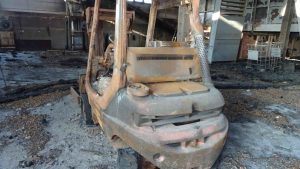Fire damage
Fire damage / fire losses in companies are usually major losses in the area of “machinery, mechanical engineering and industrial equipment”.

Fire damage is almost always major damage
Fire damage is often a major loss that can block entire businesses or areas of them for long periods of time. The german "General Fire Insurance Conditions" (AFB) are decisive for the regulation.
Fire damages, fire losses
The fire or fire damage is usually a major loss.
For the company concerned, it is always an exceptional situation. Major decisions have to be made in a short period of time. At the same time, of course, you are not familiar with such an extreme situation. In a worst-case scenario, a major loss can also jeopardize the existence of the company.
Fire damage and fire losses are most often major losses, especially when they involve machinery and industrial equipment. Prompt and professional handling of such claims is critical to restoring business continuity and minimizing financial losses. Here is some more information on the above points:
Site visit: A site visit is indeed critical to assess the exact nature and extent of the damage. Fire experts and surveyors will be on site to assess the damage, determine causes, and determine the extent of the damage. This forms the basis for the further steps. In the event of any major damage, a site visit must be carried out as quickly as possible.
Professional handling: surveyors and experts, with expertise in major fire damage and fire loss, bring their years of experience and expertise to handle the claim professionally. This includes documenting the damage, assessing the amount of damage and determining the values. An assessment of the machinery and equipment is necessary.
Determine insurance value: The determination of the insurance value of the damaged machinery and equipment is crucial, as this forms the basis for the insurance settlement. The insured value may include the current value (value at the time of damage), the replacement value (value for replacement with a new object of equal value) and other relevant values.
Determine amount of loss: Accurately determining the amount of loss is important to ensure that the insurance settlement is appropriate. This includes not only direct damage to machinery and equipment, but also potential consequential damage and business interruption costs.
Claims management: Claims management involves the coordination of all measures to restore the company’s operations. This may include procurement of spare parts, repairs, rebuilding of equipment and other necessary steps.
Through many years of experience, professional processing is assured. This makes it possible for insurers to settle quickly or initially settle in parts. That’s often where the foundation is to be able to put company divisions back into operation.
Working with surveyors and experts who specialize in fire damage and fire loss is critical to ensuring that the interests of the affected company are protected. This allows insurers to settle the claim quickly and appropriately, which in turn can help protect the company’s livelihood and facilitate reconstruction.
Expert proceedings (in case of fire damage)
The expert procedure is indeed an efficient way of resolving the differences between the expectations of the policyholder (the injured company) and the established amount of the loss, especially in the case of major losses such as fire damage.
Expensive fire damage often involves complex loss scenarios where it can be difficult to determine the exact extent and value of the damage.
The expert procedure creates more transparency in the claims settlement process and minimizes the risk of disagreements and conflicts.
Essential advantages of the expert procedure in case of fire damage and/or major damage
-
Additional expert: In an expert procedure, at least one additional independent expert is usually consulted. This expert should have expertise and experience in large claims and insurance and be able to objectively assess the amount of damage.
-
Assessment and expert opinion: The expert conducts a comprehensive examination of the damage, determines the extent of the damage to machinery and equipment, and prepares a detailed expert opinion. This expert opinion contains a determination of the amount of damage and can serve as a basis for negotiations between the policyholder and the insurance company.
-
Negotiations: After the appraisal is available, negotiations can take place between the policyholder and the insurance company based on the appraisal. This allows for a transparent discussion of the amount of the loss and the settlement of the insurance claim.
-
Dispute resolution: The expert procedure often also serves as a means of dispute resolution. If the policyholder and the insurance company cannot agree on the amount of the claim, the expert procedure can help to settle the conflict and find a fair solution.
-
Legal action: If no agreement can be reached despite the expert procedure, the policyholder can still take the legal route and go to court to enforce settlement of the claim. However, the expert process can often help to avoid expensive and protracted legal disputes.
Overall, the expert procedure can help ensure transparency and fairness in claims settlement. It allows for an independent assessment of the claim amount and promotes the efficient resolution of differences between the parties. This is especially important when dealing with major claims such as fire damage, where large financial interests are at stake.
Recommendation:
Fire damage, usually a major loss, always involves large sums of money. “Expectations” of the policyholder (injured company) and established amount of damage often differ. The expert procedure provides clarity as an efficient solution.
